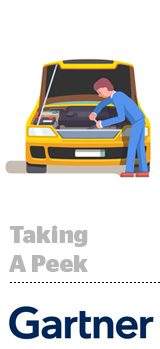
The in-housing trend prompted Gartner’s first-ever Magic Quadrant report for ad tech, which was released late last week.
Even if not all marketers are ready or interested in taking their media buying in-house, there’s a desire across the board for more control over their tech stack – or at least to know what the heck’s going on inside there.
“Previously, advertisers and marketers maybe thought of this as their agency’s problem,” said Andrew Frank, a research VP at Gartner and a co-author on the study. “Now they’re taking a more active role in assessing the technology they use.”
Stacking up
But most marketers aren’t ready to build their own tech stacks from a diverse set of providers, at least not yet, which is why the frontrunners in Gartner’s estimation are ad tech companies that provide end-to-end solutions.
To perform what Frank called an “apples-to-apples-type comparison,” Gartner focused its research on companies that provide more complete solutions built around a demand-side platform for programmatic execution.
Gartner placed Google, MediaMath, Adobe and Adform in the “leader” category, because they have stacks that can stand on their own. Adform and Adobe also scored points for good service and support, both of which appeal to marketers trying to better understand how their technology works.
Marketers are on an “accountability drive,” in part because they’re finding it difficult to understand and optimize the customer journey, and because they’re sick of “investing in technology on faith,” Frank said.
“There is a lot of concern about the value of the technology and the actual experience it’s generating,” he said. “Are my ads appearing in a safe place, are they visible, are we dealing with reputable publishers? All of these things are weighing on the mind of marketers these days.”
The Trade Desk, which fell into the “challenger” category thanks to its solid growth, is gaining new brand clients beyond its core client base of agencies because marketers are building their own internal advertising teams with an eye on increased transparency and objectivity. Amobee, also a challenger, received props for the quality of its end-user training for marketers looking to become more self-sufficient with self-serve.
On the flip side, Gartner dinged Oath (a “niche player”) for its unclear product road map and the complexity of its integrations, while Sizmek (a “visionary”) was called out for a lack of product reliability. As a whole, marketers want stability and to connect the dots, not integration headaches and messy stacks.
To be fair, both Oath and Sizmek are in transition. Oath only debuted its unified tech stack in September, and Sizmek is still in the midst of streamlining and improving its user experience after its DSP overhaul in July, and it’s uncertain how either will play out in the long term.
Watch this space
Well-known names in ad tech populated this year’s Magic Quadrant, but next year could be a different story entirely.
“We are in the middle of a consolidation phase for ad tech right now, and I don’t think it’s the last consolidation phase either,” Frank said. “As we move into the post-cookie world, we’ll see people focus more on creative and contextual targeting, which creates an opportunity for new players and maybe even a new wave of ad tech innovation.”
Here are a few more forecasts from Frank’s crystal ball:
Betting on Amazon: Gartner called Amazon a “notable mention” in its report, but “it’s clearly growing like a weed,” Frank said. “I’d be surprised if Amazon wasn’t on the Magic Quadrant next year.” So would Martin Sorrell.
Gung-ho on telcos: AppNexus wasn’t included in the 2018 ad tech Magic Quadrant due to its recent acquisition by AT&T, but as a part of Xandr, AT&T’s new advertising unit, it could make an appearance soon. “I would expect Xandr to be a contender in the future – they’ve clearly made some big commitments in this space,” Frank said. “More generally, we’ll also be keeping an eye on the plays being made by the big telco companies.”
IDentifying an opportunity: Google recently restricted the use of its advertising ID, and that could benefit its competitors in the Magic Quadrant. “The ad server space is one that Google has dominated for quite some time, and any competition there can only be healthy for the market,” Frank said.
The clouds: Out of all the big marketing clouds, Adobe is still the only one that’s incorporated a DSP into its stack and integrated it with analytics. Oracle and Salesforce have begged out of that for now, citing the need for media neutrality – but never say never.
Adobe could be in for some competition on the DSP front eventually. “Of course, it depends on how you define ‘eventually,’” Frank said. “As long as there’s unmet demand, there will be pressure on the marketing clouds to meet it with products of their own – but I wouldn’t confuse a clear view with a short distance in this case.”
This post was syndicated from Ad Exchanger.


More Stories
WPP’s Q1 Revenues Slide 5%, but Tariffs Aren’t to Blame
Revolving Door Roundup: Gary Tuchman Departs CNN After 35 Years
The Winners and Losers of Google’s Big Cookie Reversal